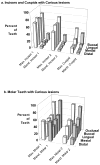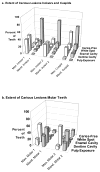Aciduric microbiota and mutans streptococci in severe and recurrent severe early childhood caries
- PMID: 22583872
- PMCID: PMC3353719
Aciduric microbiota and mutans streptococci in severe and recurrent severe early childhood caries
Abstract
Purpose: Severe early childhood caries (ECC) results from bacterial acid production in an acidic environment. The purpose of this study was to determine Streptococcus mutans, Streptococcus sobrinus, and acid-tolerant counts in severe early childhood caries.
Methods: Two- to 6-year-olds with severe-ECC (N=77) or who were caries-free (N=40) were examined. Plaque samples from teeth and the tongue were cultured anaerobically on blood, acid, and S. mutans selective agars. Severe-ECC children were monitored post-treatment for recurrent caries.
Results: Severe-ECC and caries-free children were balanced by household income and education level. Carious lesions were observed in 75% maxillary incisors and >80% molars in severe-ECC. At baseline, S. mutans, and S. sobrinus counts and proportions of S mutans were higher in severe-ECC than caries-free children. Acid and blood counts were elevated only in anterior samples of severe-ECC children. Baseline counts of S. sobrinus, but not S. mutans, were higher in children with recurrent compared with no recurrent caries. S. mutans counts were lower following treatment than pretreatment, particularly for children without caries recurrence. Other counts did not differ between before and after therapy.
Conclusions: Severe and recurrent early childhood caries was better explained by mutans streptococci than the aciduric microbiota. Streptococcus mutans did not predict children with recurrent caries.
Figures






Similar articles
-
Quantitative real-time polymerase chain reaction for Streptococcus mutans and Streptococcus sobrinus in dental plaque samples and its association with early childhood caries.Int J Paediatr Dent. 2009 Mar;19(2):141-7. doi: 10.1111/j.1365-263X.2008.00942.x. Int J Paediatr Dent. 2009. PMID: 19250396
-
Diet and caries-associated bacteria in severe early childhood caries.J Dent Res. 2010 Nov;89(11):1224-9. doi: 10.1177/0022034510376543. Epub 2010 Sep 21. J Dent Res. 2010. PMID: 20858780 Free PMC article.
-
Correlation of streptococcus mutans and streptococcus sobrinus colonization with and without caries experience in preschool children.Indian J Dent Res. 2020 Jan-Feb;31(1):73-79. doi: 10.4103/ijdr.IJDR_432_18. Indian J Dent Res. 2020. PMID: 32246686
-
Mutans streptococci caries and chlorhexidine.J Can Dent Assoc. 1996 Sep;62(9):700, 703-7. J Can Dent Assoc. 1996. PMID: 8908872 Review.
-
Cariogenicity depends more on diet than the prevailing mutans streptococcal species.J Dent Res. 1996 Jan;75(1):535-45. doi: 10.1177/00220345960750010501. J Dent Res. 1996. PMID: 8655757 Review.
Cited by
-
Xylitol and erythritol inhibit real-time biofilm formation of Streptococcus mutans.BMC Microbiol. 2020 Jun 29;20(1):184. doi: 10.1186/s12866-020-01867-8. BMC Microbiol. 2020. PMID: 32600259 Free PMC article.
-
Evaluating the relationship between acidogenicity and acid tolerance for oral streptococci from children with or without a history of caries.J Oral Microbiol. 2019 Nov 7;12(1):1688449. doi: 10.1080/20002297.2019.1688449. eCollection 2020. J Oral Microbiol. 2019. PMID: 31893016 Free PMC article.
-
A novel multiplex fluorescent-labeling method for the visualization of mixed-species biofilms in vitro.Microbiol Spectr. 2024 Jul 2;12(7):e0025324. doi: 10.1128/spectrum.00253-24. Epub 2024 May 24. Microbiol Spectr. 2024. PMID: 38785429 Free PMC article.
-
Cultivable anaerobic microbiota of severe early childhood caries.J Clin Microbiol. 2011 Apr;49(4):1464-74. doi: 10.1128/JCM.02427-10. Epub 2011 Feb 2. J Clin Microbiol. 2011. PMID: 21289150 Free PMC article.
-
Silver Fluoride as a Treatment for Dental Caries.Adv Dent Res. 2018 Feb;29(1):135-140. doi: 10.1177/0022034517743750. Adv Dent Res. 2018. PMID: 29355428 Free PMC article. Review.
References
-
- Tinanoff N, Kaste LM, Corbin SB. Early childhood caries: a positive beginning. Community Dent Oral Epidemiol. 1998;26(1 Suppl):117–19. - PubMed
-
- Beltran-Aguilar ED, Barker LK, Canto MT, Dye BA, Gooch BF, Griffin SO, et al. Surveillance for dental caries, dental sealants, tooth retention, edentulism, and enamel fluorosis--United States, 1988–1994 and 1999–2002. MMWR Surveill Summ. 2005;54(3):1–43. - PubMed
-
- Grindefjord M, Dahllöf G, Nilsson B, Modeer T. Stepwise prediction of dental caries in children up to 3. 5 years of age. Caries Res. 1996;30(4):256–66. - PubMed
-
- Berkowitz RJ. Causes, treatment and prevention of early childhood caries: a microbiologic perspective. J Can Dent Assoc. 2003;69(5):304–07. - PubMed
Publication types
MeSH terms
Substances
Grants and funding
LinkOut - more resources
Full Text Sources
Medical

